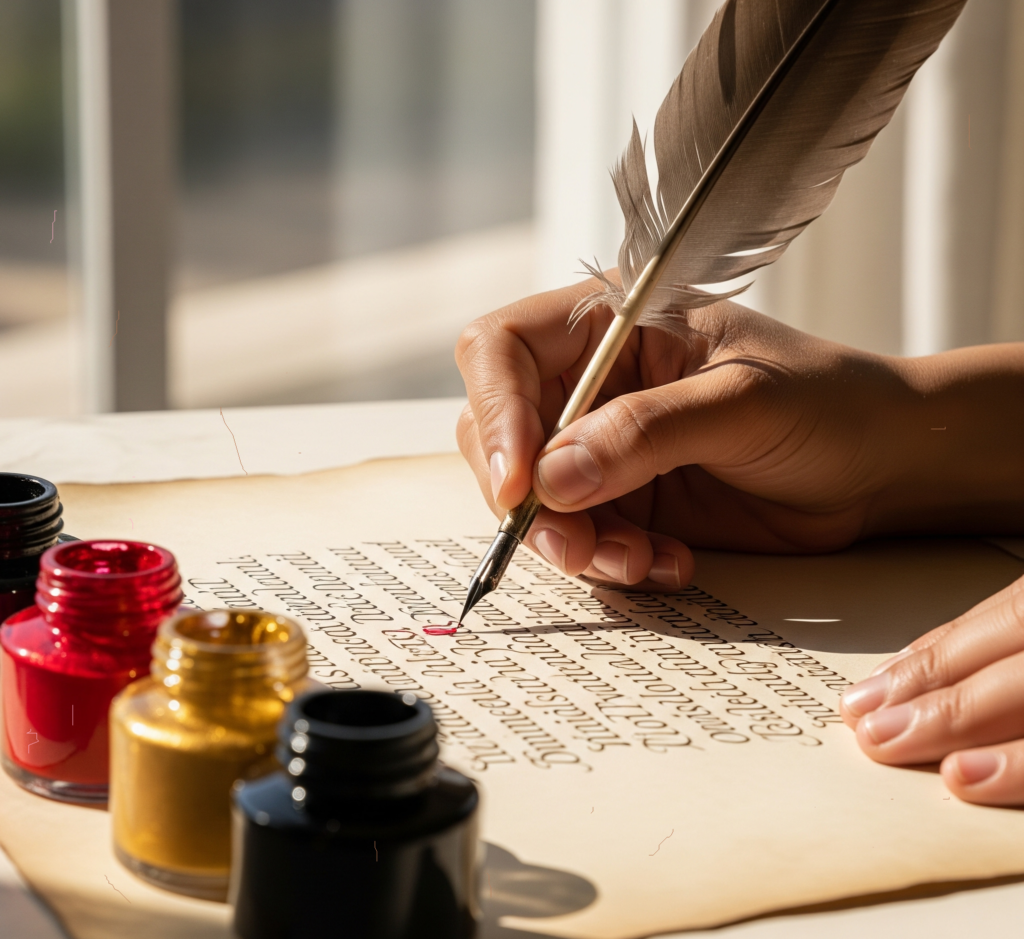
Writing with a feather might sound like something from the pages of history, but it’s a beautiful and functional art form still practiced today. Known as quill pens, these writing tools were once the standard in Europe for over a thousand years. They remain popular for calligraphy, historical reenactments, and hobby crafting.
This guide covers everything from which bird feathers to choose, how to make a quill pen, and what ink to use, to the actual experience of writing with one.

Find quill pens on Amazon
🪶 What Type of Feather and Which Bird’s Feather?
Not every feather will make a good quill. The best quills are made from primary flight feathers — the long, stiff feathers on the outer wings of birds. These are naturally strong, slightly curved, and hollow enough to hold ink.
✅ Birds for Quill Pens:
| Bird | Feather Type | Why It’s Used |
|---|---|---|
| Goose | Primary wing feather | Durable, classic choice; holds ink well |
| Swan | Wing feather | Elegant and prestigious, but less accessible |
| Turkey | Wing feather | Widely available in North America; strong and large |
| Crow/Raven | Smaller wing feather | Ideal for fine detail work or smaller writing |
| Owl/Eagle | Large wing feather | Rare and symbolic; strong structure |
| Macaw | Wing or tail feather | Decorative option for color and shape |
✨ Tip: Right-handed writers prefer left-wing feathers; left-handers may use right-wing feathers for better nib angle alignment.
🐔 Can Chicken Feathers Be Used?
Yes, but with limitations.
Chicken feathers (especially tail or wing feathers) can be used for beginner practice, but they’re:
- Too soft
- Less durable
- Prone to fraying
They work best for DIY crafts or children’s projects, but not ideal for long writing sessions or professional calligraphy.
🔗 Find feathers for Feather Quill Projects for Kids and Hobbyists
🛠️ How to Make a Feather Pen (Quill) – Step-by-Step
Creating a quill pen requires curing, cutting, and shaping the feather tip.
🧰 Materials You’ll Need:
- Large feather (e.g., goose or turkey)
- Sharp craft knife or X-Acto blade
- Fine sandpaper (optional)
- Ink for dip pens
- Hot sand or flame source (for tempering)
👉 Optional DIY Kit:
🔗 Feather Quill Pen Making Set with Cutter & Ink (Amazon)
✂️ Step-by-Step Instructions
1. Select a Feather
Choose a clean, stiff, full-length feather.
2. Clean and Dry
Wash gently with warm soapy water, and allow to air dry.
3. Harden the Shaft
Use hot sand or pass the nib end quickly through a candle flame to harden it.
4. Strip & Shape the Grip
Trim away some barbs near the end for easier grip and visibility.
5. Cut the Nib
Carve a 45° angle, add a small center slit, and smooth the edges using sandpaper.

Find quill pens on Amazon
🎥 Want visuals?
📺 Watch: How to Cut a Feather Quill Nib – YouTube Tutorial
✍️ What’s It Like to Write with a Quill?
| Feature | Notes |
|---|---|
| Ink Refill | Frequent dipping — every 2–3 words |
| Grip Pressure | Light grip required; too much pressure splits the nib |
| Paper Type | Smooth surfaces like parchment or Bristol work best |
| Ink Flow | Flow may vary based on nib cut and ink type |
| Drying Time | Expect smudges — blotting paper is recommended |
✍️ Want smoother writing? Try pairing your quill with high-quality paper.
🔗 Find Paper for Dip Pens – Calligraphy Sets on Amazon
🖋️ Best Inks for Feather Pens
✅ Ideal Ink Types:
| Ink Type | Pros | Best For |
|---|---|---|
| Calligraphy Ink | Smooth, pigment-rich, made for dip pens | Beginners, general writing |
| Walnut Ink | Organic, sepia-toned, natural flow | Vintage art, historical effects |
| Iron Gall Ink | Traditional, deepens over time | Experienced users, archival writing |
❌ Avoid:
- India Ink – Too thick, clogs nibs
- Ballpoint Ink – Not suitable at all
💡 Tip: Never use ink meant for fountain pens — it’s too thin for quills.
🔗 Find Calligraphy Ink Bottles on Amazon
💡 Tips for Success
- ✅ Use blotting paper to avoid smudging
- ✅ Always clean the nib after each session
- ✅ Store quills vertically in a pen holder
- ✅ Recut the nib regularly as it wears down

Find quill pens on Amazon
🎨 Final Thoughts
Crafting a feather pen is more than just a DIY project—it’s a personal link to centuries of literary tradition. Whether you’re a calligraphy enthusiast, a history lover, or a creative writer, making your own quill is an art form worth exploring.
Even a simple chicken feather can help spark your imagination and bring a bit of old-world magic to your modern life.
💬 Have You Tried a Feather Quill?
Tell us your experience in the comments! Share your nib style, ink type, or even a photo of your writing.
🧾 Affiliate Disclosure
This blog contains affiliate links. If you click and purchase through these links, I may earn a small commission at no extra cost to you. This helps support the blog and allows me to continue creating useful, free content. Thank you for your support!
👤 About the Author
Hi, I’m Sujith, a content creator passionate about blending traditional techniques with modern creativity. From feather pens to AI art, I explore everything that sparks curiosity and craftsmanship. Follow me for more guides, tools, and tutorials that inspire artistic expression.